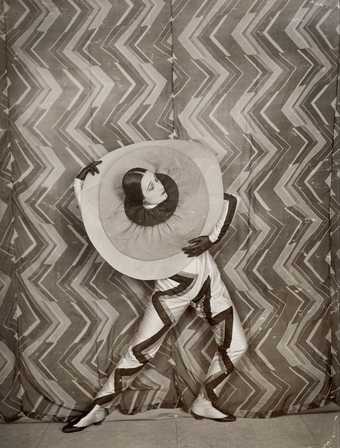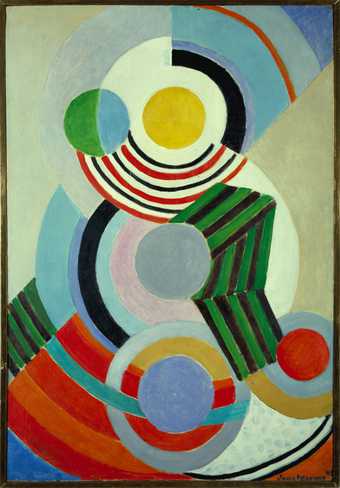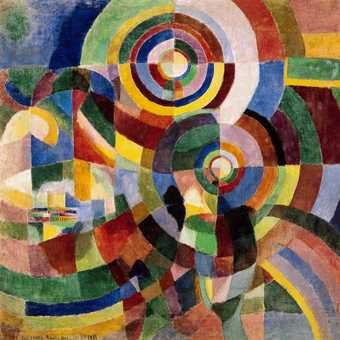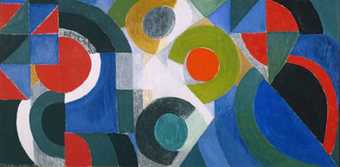
wearing the Pierrot-Éclair costume designed by Sonia Delaunay, on the set of René Le Somptier’s film Le P’tit Parigot 1926
© Bibliothèque nationale de France, Paris
Sonia Delaunay (1885–1979) was an avant-garde artist who spent her life experimenting with the language of colour and abstraction. She developed a varied practice that was sympathetic to the later concerns of the Bauhaus school, with its aim to bring art back into contact with the everyday, giving equal weight to design and fine art. While remaining consistently faithful to abstract painting, she created some of the most innovative designs of the interwar years, from typography and advertising to radical costumes for the Ballets Russes, bold textile prints, handmade garments and ready-to-wear fashion, dada outfits for stage and film, and tapestry, mosaic and interior design.
Delaunay believed that fashion and design were a way to reveal and embed the new visual language of abstract painting in daily life and to reach a broader audience. Throughout the 1910s and 1920s, with her painter husband Robert Delaunay (1885–1941), she advocated a theory of simultaneous colour contrasts across all artforms. During her 60 years as an artist she strove to advance the cause of abstraction, yet is only belatedly recognised for her groundbreaking practice, somewhat overshadowed by her husband during his lifetime.
Born Sara Elievna Stern in Odessa in 1885, Sonia was the youngest of three children, and adopted the name Sonia Terk when she went at the age of seven to St Petersburg to live with her maternal uncle, Henri Terk. Well educated and adept at a number of languages, she considered herself Russian, though spent most of her cosmopolitan adult life in Paris, as well as significant periods of study and work in Finland, Germany, Portugal and Spain. She was part of the artistic milieu that included poets, artists, writers, musicians and other intellectuals from many parts of the world who together made the French capital such a nodal point in the evolution of modern art.

Sonia Delaunay
Rhythm 1945
Grey Art Gallery
New York
© Pracusa 2014083
Having settled in Paris in 1906, Sonia’s position as a Russian émigré enabled her to engage with the ideas of both the French and Russian avantgardes, creating a radical fusion in her work. She thrived at a time when the rapidly changing society afforded greater opportunities to modern women, entering into a marriage of convenience with the gay art critic and dealer Wilhelm Uhde (1874–1947) in order to stay in the city.
Uhde encouraged her talent and mounted her first solo exhibition of figurative paintings – informed by fauvism and expressionism – in 1908. Having formed a friendship with the young, ambitious painter Robert Delaunay the previous year, they married in 1910, and their collaborative partnership and utopian aesthetic saw their rise as a couple that embodied an entire fashion in French modern art. In 1913 Robert wrote: ‘Line is limitation. Colour gives depth – not perspectival, not successive, but simultaneous depth – as well as form and movement.’ These sentiments were echoed by Sonia in 1949:
The real new painting will has a life of its own, that the infinite combinations of colour have poetry and a language much more expressive than the old methods. It is a mysterious language in tune with the vibrations, the life itself, of colour. In this area, there are new and infinite possibilities.
Sonia made her dramatic entrance on to the international art scene at the first German Salon d’Automne at Der Sturm in Berlin in 1913, where she exhibited five paintings, collaged bookbindings, painted boxes and fabrics with abstract titles. Her radical works baffled the critics. The clothing and household objects she designed were assemblages of fabrics in a variety of colours and materials, sewn using traditional Slavic techniques and first seen in a blanket for her son in 1911.
Also in 1913, she designed a ‘Simultaneous dress’ for herself for evenings at the Bal Bullier, the buzzing Parisian ballroom where artists in her circle met regularly, which reiterated motifs such as the rainbow arc and solar disc used in her applied designs. Sonia broke from conventional behaviour in the way that she presented herself, literally living her own art, positioning her as a progressive woman, synonymous with movement and modernity. (Robert Delaunay said that the dress fashioned her as ‘a living sculpture… a sculpture of living forms’). She was also working with the principle of simultaneous contrast in her paintings, as seen in her series of Bal Bullier canvases created during 1912 and 1913, with their contrasting colours and abstracted figures.

Sonia Delaunay
Prismes electriques 1914
Centre Pompidou Collection, Mnam / Cci, Paris
© Pracusa 2013057
For the Delaunays, Paris – and in particular the Eiffel Tower – were emblematic of modern life. The city and its rhythms provided the source for Sonia’s work, from the dynamic Electric Prisms (Prismes électriques)paintings of 1913 and sketches of crowds on the boulevard Saint-Michel (inspired by the arrival of electric street lights) to her playful coloured lettering – black for A, white for E, red for I, blue for O, green for U. Her typographic studies for headed paper included the capital ‘A’ from Delaunay hanging on to the outline of the Eiffel Tower as if it were a logo of an international brand.
Poetry was a lifelong passion and Sonia further developed her avant-garde ideas in various poetry works and projects. She collaborated with poet Blaise Cendrars (1887–1961) on the illustration of the experimental colour-poem La Prose du Transsibérien et de la petite Jehanne de France (Prose of the Transsiberian and of little Jehanne of France) in 1913. This was her first attempt at transcribing spoken words through colour, interpreting the relationship between writing and coloured painting – or, as she referred to it, ‘synchromatic presentation’. The poem-painting was printed on a two-metrelong sheet and coloured with pochoir (stencil), the intention being to print a numbered edition which, if stretched end-to-end, would reach to the top of the Eiffel Tower. Of the Delaunays, Cendrars wrote: ‘I like the Delaunays’ painting, full of suns, rutting and violence. Mrs Delaunay has made such a beautiful book of colours that my poem is more soaked in light than my life.’
Sonia went on to merge poetry with fashion design. In the 1920s she made designs for several ‘dress-poems’ based on the writings of the dadaist poet Tristan Tzara (1896–1963) and surrealist author Joseph Delteil (1894–1978). Her interest in costume and dance was brought together in 1918 when she accepted Diaghilev’s invitation to design costumes for the Ballets Russes, creating daringly modern outfits for Cléopâtre. She also designed costumes for dada events, including Tzara’s absurdist play Le Coeur à gaz (The Gas Heart, 1923) and Danseuse aux disques (Dancer with Discs, 1923), and scenery and costumes for a central scene in René Le Somptier’s film Le P’tit Parigot (The Little Parisian, 1926) and for Marcel L’Herbier’s film Le Vertige of 1926. Her textiles and fashion designs of the 1920s saw simultanism escape the confines of art and go directly to the streets, into everyday life. As in her Simultaneous dress, her costumes suggested movement in the concept of the design and a transformation of the female body.
During an extended stay in Spain and Portugal due to the outbreak of the First World War, Sonia established the firm Casa Sonia in Madrid in 1918 to promote her simultanist clothing and interior designs. It met with a certain success, but not enough to support the Delaunays following the impact on their family fortune of the Russian Revolution, and they had to rely on various loans during the 1920s and 1930s. Upon her return to Paris in the early 1920s, she opened a boutique and fashion house on the boulevard Malesherbes. In 1923 she sold simultaneous designs to a silk manufacturer in Lyon, and in 1924 set up an atelier for printing fabrics and producing clothing and scarves.
She often staged her models for shoots against competing textile patterns, draping fabric in a similar way to emphasise the patterning on the designs. In 1925 the Parisian couturier Jacques Heim invited her to participate in the International Exposition of Modern Decorative and Industrial Arts in Paris, where she designed the Simultané boutique to display her embroidered and geometrically patterned coats, bags, scarves and jackets. Photographs of models in her clothes began to circulate and the press response was enthusiastic, raising her profile among an international clientele who included the wives of the architects Walter Gropius, Marcel Breuer and Erich Mendelsohn, and celebrities such as American film star Gloria Swanson, English muse Nancy Cunard and architect Ernö Goldfinger.

Sonia Delaunay
Triptych 1963
Oil on canvas
99.7 x 200 cm
© Tate
Photo: Image © L&M Services B.V. Amsterdam 20060212
In 1937 Robert and Sonia contributed works to the Paris International Exposition, which focused on art and technology in modern life. The centrepiece of the Spanish pavilion was Pablo Picasso’s Guernica. Sonia executed monumentally scaled mural paintings titled Motor, Dashboard and Propeller for the pavilion dedicated to air travel, and Faraway Voyages and Portugal for the space representing railways. In the last two works, she drew upon the years she had spent in Portugal.
Following Robert’s death in 1941, Sonia concentrated on the promotion of his practice and continued her support of abstract art, only gradually beginning to focus on her own career as a painter. She exhibited regularly at the Salon des Réalités Nouvelles during the 1940s and 1950s, giving herself more formal freedom in the works she created from then on. Seeking contrast and tension, she placed semicircles and concentric circles against angular forms such as squares, triangles and lozenges. And she exploited the rhythmic effect produced by the repetition of a single motif against the background of the painting. Her works at this time reveal a great use of black, which created vibrant contrasts with the intense blues, reds and greens, as seen in paintings such as Coloured rhythm (Rythme coloré) 1958.
From the 1950s Sonia began to exhibit her own paintings in Europe and America, and in 1964 became the first living female artist to have a retrospective at the Louvre. In 1965 a room was devoted to her fabric designs and dresses at the exhibition L’Expo 1925 at the Musée des Arts Décoratifs, and in 1967 the Musée National d’Art Moderne held a full-scale retrospective of her work.
This shift within her practice away from design and her involvement in various groups for the defence of abstract art (Salon des Réalités, Nouvelles, Groupe Espace) saw her contributing to the second wave of abstraction in Europe. Towards the end of her life, she was drawn to using gouache, creating accomplished compositions which informed the direction of her work in other media, such as tapestries that imitated the effect of lead pencil rubbing against paper. From the early 1970s she dedicated herself to producing editions of lithographs and related products, including the geometric expressions in the print portfolio Avec moi-même (With Myself) of 1970.
Sonia Delaunay spanned the full arc of the adventure of abstraction in Europe across the first half of the 20th century. One of the early pioneers, she helped to bring art and life together in the period between the First and Second World Wars and continued to champion the cause of abstraction as a universal visual language in the post-war era. As she wrote in her autobiography: We Will Go Right Up to the Sun (Nous irons jusq’au soleil) in 1978, one year before she passed away: ‘What had people been saying about me up to then? – muse of Orphism, decorator, Robert Delaunay’s partner. Then they conceded: “collaborator, continuer…” before admitting that the work existed in its own right.’
